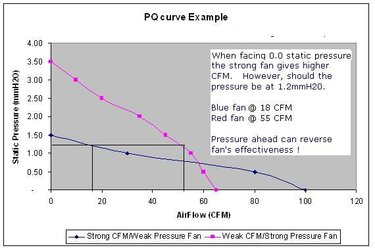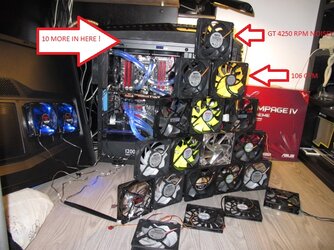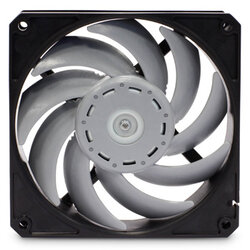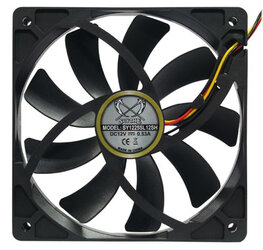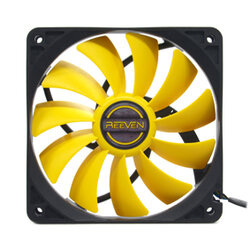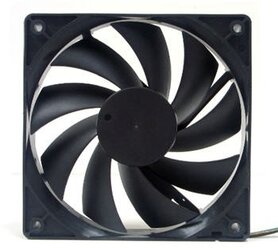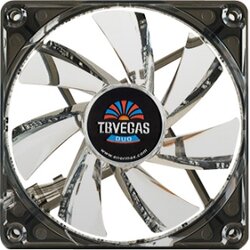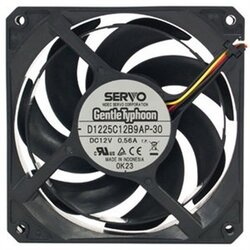I have noticed a LARGE number of people asking about Fans, and I see Corundrum and Mo7tif3r working very hard to answer them every time, so I decided to help out, and write an 101 for Picking fans here.
Start with knowing this:
Someone else's best fan, might not be yours,
there are many types of fans, and depending on use and placement, and noise tolerance,
what you consider as best, might not be universal.
Before we go any further. there are 2 things we need to explain.
This will be:
1, PQ curve, and
2, dBA (a sub-class of dB).
Which is basically the FAN's effectiveness across different pressures, and the basic measurement with Noise.
PQ CURVE
This basically tells you which fan to pick in what situation: therefore important. Most manufactures will ONLY tell you the strong specs of the fan, and this is usually the CFM, however, a fan with strong CFM, 'can' have a surprisely low Static pressure. MEANING, the wind can 'bounce back' when obstructed rendering the airflow MUCH lower than the official specs (which is measured when the FAN has no obstacle). On the chart, Y-axis is head on pressure, X-axis is airflow.
To understand further. Imagine this:
You have a fan blowing in a tunnel.
at the end of the tunnel, you feel the air flow, the total air moved here is the CFM (cubic feet per minute). Now, if in the middle of the tunnel, there's a CAGE. High pressure dense wind will make it through, but low pressure wind will grind to a halt. This is the Static Pressure's pressence, and in this analogy, your RADIATOR, is the Cage inbetween.
You will ask, WHAT FANS has high Static Pressure?
In 'general' these will be the fans with DENSE-FINs, like the Gentle Typhoon series. cause of the dense fins, it is more difficult for the wind to 'slip backwards', as a result: Higher pressure. The opposite will be like those 3-fin fans, which they can BLOW LOTS OF AIR, put your hand in front, and the air will flow backwards as it bounces back.
Don't want to buy new fans, but want some improvements?
THERE ARE THINGS THAT CAN HELP YOU:
There are intake shrouds. (looks like a large shallow funnel), these will assist in generating a higher Static pressure, as the wind can't slip back though the edges.
There are outlet shrouds. Which can be placed between the Fan and Radiator. This helps to eliminate the FAN's Blind spot (the rotary center) BOTH of these tools can help with better FAN performances.
Remember: PQ Curve is the actual AirFlow measured, depending on what pressure obstacle lays in front of the Fan. A good PQ curve is convex in shape, if I ever write about pumps, this will concept will come back again.
Decibels dB
dB is an exponential scale. Meaning between 10dB and 20dB, the energy ratio is x10, not x2. Cause of this, the difference between 20dB and 30dB, is VERY different from 80dB to 90dB. It is commonly mistaken that 60dB is just 3 times of 20dB, but in fact, on the Power level, it is 10,000 times stronger, and to the ears, at least x16 times louder. (from 20dB -> 60dB, a quick rule of thumb is the ear perceives 10dB as around twice as loud, so 20dB to 60dB is x2x2x2x2 = x 16!) above 60dB though this rule doesn't hold well anymore, and you REALLY feel the exponential power. see chart below.
Now:
In general, any fans under 30dB is quiet. Under 20dB you hardly can hear anything. 40dB makes a very audible HUM, 50dB is like a printer functioning, 60dB is like having a person talking loud next to you. For some reason, some reseaches like to think the difference between 10dB and 28dB is worth separately fan's quality, but at those levels, it is sorta pointless to separate the noise quality.
When you pick a fan:
Anything above 35dB is getting loud,
Anything above 45dB, forget about it if you want a quiet PC,
Anything under 25dB has next to no noise.
Think that way instead, much easier understanding of those numbers.
SI Unit is dB, dBA is dB "contour filtered" to human hearing range. it is necessary, as human ears are only sensitive between 20hz - 20k Hz, above and below, it can be at 200 dB and you still won't know it. Also, the human ear's sensitivity is very poor near the edge of the hearing range, Example is your Sub-woofer Or Dog Whistle. a Dog Whistle can measure over 100 dB in close range, but nope to you it is just wind, sub-woofer easily register around 120dB, but to you, it is just a 'thud' within hearing range, usually dB at lower frequencies usually means lower dBA value. (if be funny to make the computer sqeek at 30k Hz, meaning, you can't hear anything, but your dog won't ever enter your room.)
You can consider dBA as dB with an adjustment, and usually dB > dBA except within 1000 hz -> 5000 hz range.
Now all that being said.
I divide FAN use in Computer Cooling into 3 groups:
1, For Radiators:
In this catagory, you have a few considerations, but it surrounds wanting a Good ratio between CFM and Static pressure. Cause you have a radiatior, which obstructs airflow, FANS with low static pressure can have as low as <20% effectiveness. Whereby high static pressure fans can maintain as high as 75%-80%. However, do not despair. If you have your fans in PUSH/PULL config (meaning one behind and one in front of the radiator), the effective nullifies most pressure problem of fans, and in most cases, even low static pressure fans can get a good CFM through. Which however, increases Noise.
If Noise is a problem for you. You need MORE radiators.
With more radiators you can afford just using the Gentle Typhoon AP-15, and still get great performance. If you don't mind minor noise, get the SlipStream 1900 RPM in push/pull config, you will get great performance as well. There are many fans inbetween these two extremes too of course. If you are deaf, (or a die-hard overclocker benching for results.) you can also pick some 4-pin Molex fans, that can easily get 200 CFM through those radiators at 60dB+. like the Gentle-Typhoon 5400 RPM (or Delta Server fans), yes, performance is AWESOME, but I can swear you go deaf sitting next to it for an afternoon.
Also bring this knowledge when you purchase your Radiators too. Low FPI (fin per inch) Radiators usually have ard 10-15 FPI, these are situable for weaker fans. Radiators with higher FPI (20+) are usually considered as higher quality, however to harvest that quality, you -need- stronger fans. Usually, if you go for higher FPI rads, going push/pull is a strong bonus, whereby low FPI rads are great for quieter systems. Both types of Rads are good, they just fill different roles.
Here is a perfect place to remember one more thing:
When you place FANS in SERIES (like in push/push), You ADD the static pressure, CFM stays same.
When you place FANS in PARALLEL, you add the CFM, and static pressure stays same.
If you wonder how to set up ur fans, martin's lab did a great study, see below:

Image credit to martin liquid lab
http://martinsliquidlab.org/2012/06/08/hesmelaughs-radiator-sandwich-testing
2, For AirFlow: Chassis FANS
Here, the choice is much easier. While static pressure still a good thing to have as high as possible, the general rule is higher CFM the better. Just weight that against how noisey a FAN is, and you be alright.

In general, you want to have a NET POSITIVE pressure in your chassis. If you know all the CFM of the fans, then the math is easy, just be sure the intakes is roughly 50CFM more than exhausts, and you be golden.
Also, general rule is that we like Fans to blow-in from front and side, exit back and top. Reason being hot air naturally raises, though easily overcome, there's little reason to fight nature's way. Of course, obstructions outside of your chassis matters too, and you need to be flexible. In general, most people that have internal Radiators, like to have RADS as exhaust, as blowing air through the rad as intake, can heat up your chassis by up to 10'C-15'C. Of course, that's why many of us, consider external radiators too, which usually gives good performance in cost of good looks.
Take note, many 38mm FANs at LOWER RPM actually gives pretty good ratio of such, don't forget looking into those. A good example will be Ultra Kaze 38mm Fan, or Cooler Master's turbine. Of course, I care about the looks too. I personally think Enermax fans gives a good balance between Performance and Noise here. Love them.
Noctua fans actually perform well too, but they are ... not my colors.
3, Very quiet fans
Some people cannot stand noise, and in this catagory, you don't have much to pick from, most fans will operate at <50CFM, but if you want it quiet, that's the performance you give up. (you can always construct a audio-insultating box for your computer if you want both.) To compensate, get more radiators to dissipate the heat better. If you are NOT on water cooling, then you need to watch your temps, and on air cooling.. chances are, using the most quiet fans will affect your clock speed, as you are bound to overheat. what you can do, is add copper fins to very hot surfaces, increase the surface area will help the heat dissipation, A LOT. Another solution, is applying some acoustic insulating foam on your chassis, I did so as I am a perfectionist, however, that only reduce the noise 'ever so slightly', (on the meter, just a 36dB -> 34dB reduction. makes me happy.)
With this. Hopefully it will help your understanding of fans.
and remember, fans are MOST abundant at the 120mm size, that is why most of us use that width for radiators. As we have most choices there, and can be much more flexible. Also note many chassis are made for you to use 120 radiators too.
QUICK GUIDE on fan specs:
AIRFLOW:
<50 CFM is weak. probably a fan marketted for be 'super quiet'.
>80 CFM is good.
>90 CFM is great.
(please note, some use CMH, 0.6xCMH = CFM )
PRESSURE:
> 2.8MMH20 = good enough.
(please note, some use mmHg instead. 1mmHg = 13.6mmH20)
NOISE:
<25 = super quiet.
<35 = acceptable.
>42 = really think twice if u next to computer.
ENJOY!
Update: 07-Jan-2014
- The last 4-6 months has been decent for fans. Many more fans are now avail and much more easily so as well.
Of course, I have been testing. and here are some of my new favorities:
- Scythe GentleTyphoon Ap-29 3000 rpm. This beast at max 36.5dB, but can pack a DENSE PUNCH, Excellent for radiators!
- CoolerMaster Jetflo 120mm 1600 rpm. This fan has 95CFM, however I find the static pressure less than the advertised, but as a chassis fan it is still excellent, for the cost.
Start with knowing this:
Someone else's best fan, might not be yours,
there are many types of fans, and depending on use and placement, and noise tolerance,
what you consider as best, might not be universal.
Before we go any further. there are 2 things we need to explain.
This will be:
1, PQ curve, and
2, dBA (a sub-class of dB).
Which is basically the FAN's effectiveness across different pressures, and the basic measurement with Noise.
PQ CURVE
This basically tells you which fan to pick in what situation: therefore important. Most manufactures will ONLY tell you the strong specs of the fan, and this is usually the CFM, however, a fan with strong CFM, 'can' have a surprisely low Static pressure. MEANING, the wind can 'bounce back' when obstructed rendering the airflow MUCH lower than the official specs (which is measured when the FAN has no obstacle). On the chart, Y-axis is head on pressure, X-axis is airflow.
To understand further. Imagine this:
You have a fan blowing in a tunnel.
at the end of the tunnel, you feel the air flow, the total air moved here is the CFM (cubic feet per minute). Now, if in the middle of the tunnel, there's a CAGE. High pressure dense wind will make it through, but low pressure wind will grind to a halt. This is the Static Pressure's pressence, and in this analogy, your RADIATOR, is the Cage inbetween.
You will ask, WHAT FANS has high Static Pressure?
In 'general' these will be the fans with DENSE-FINs, like the Gentle Typhoon series. cause of the dense fins, it is more difficult for the wind to 'slip backwards', as a result: Higher pressure. The opposite will be like those 3-fin fans, which they can BLOW LOTS OF AIR, put your hand in front, and the air will flow backwards as it bounces back.
Don't want to buy new fans, but want some improvements?
THERE ARE THINGS THAT CAN HELP YOU:
There are intake shrouds. (looks like a large shallow funnel), these will assist in generating a higher Static pressure, as the wind can't slip back though the edges.
There are outlet shrouds. Which can be placed between the Fan and Radiator. This helps to eliminate the FAN's Blind spot (the rotary center) BOTH of these tools can help with better FAN performances.
Remember: PQ Curve is the actual AirFlow measured, depending on what pressure obstacle lays in front of the Fan. A good PQ curve is convex in shape, if I ever write about pumps, this will concept will come back again.
Decibels dB
dB is an exponential scale. Meaning between 10dB and 20dB, the energy ratio is x10, not x2. Cause of this, the difference between 20dB and 30dB, is VERY different from 80dB to 90dB. It is commonly mistaken that 60dB is just 3 times of 20dB, but in fact, on the Power level, it is 10,000 times stronger, and to the ears, at least x16 times louder. (from 20dB -> 60dB, a quick rule of thumb is the ear perceives 10dB as around twice as loud, so 20dB to 60dB is x2x2x2x2 = x 16!) above 60dB though this rule doesn't hold well anymore, and you REALLY feel the exponential power. see chart below.
View attachment dB range chart.bmp
-image credit to neoseeker.com
-image credit to neoseeker.com
Now:
In general, any fans under 30dB is quiet. Under 20dB you hardly can hear anything. 40dB makes a very audible HUM, 50dB is like a printer functioning, 60dB is like having a person talking loud next to you. For some reason, some reseaches like to think the difference between 10dB and 28dB is worth separately fan's quality, but at those levels, it is sorta pointless to separate the noise quality.
When you pick a fan:
Anything above 35dB is getting loud,
Anything above 45dB, forget about it if you want a quiet PC,
Anything under 25dB has next to no noise.
Think that way instead, much easier understanding of those numbers.
SI Unit is dB, dBA is dB "contour filtered" to human hearing range. it is necessary, as human ears are only sensitive between 20hz - 20k Hz, above and below, it can be at 200 dB and you still won't know it. Also, the human ear's sensitivity is very poor near the edge of the hearing range, Example is your Sub-woofer Or Dog Whistle. a Dog Whistle can measure over 100 dB in close range, but nope to you it is just wind, sub-woofer easily register around 120dB, but to you, it is just a 'thud' within hearing range, usually dB at lower frequencies usually means lower dBA value. (if be funny to make the computer sqeek at 30k Hz, meaning, you can't hear anything, but your dog won't ever enter your room.)
You can consider dBA as dB with an adjustment, and usually dB > dBA except within 1000 hz -> 5000 hz range.
View attachment dBA.bmp
-conversion chart from old lab notes.
-conversion chart from old lab notes.
Now all that being said.
I divide FAN use in Computer Cooling into 3 groups:
1, For Radiators:
In this catagory, you have a few considerations, but it surrounds wanting a Good ratio between CFM and Static pressure. Cause you have a radiatior, which obstructs airflow, FANS with low static pressure can have as low as <20% effectiveness. Whereby high static pressure fans can maintain as high as 75%-80%. However, do not despair. If you have your fans in PUSH/PULL config (meaning one behind and one in front of the radiator), the effective nullifies most pressure problem of fans, and in most cases, even low static pressure fans can get a good CFM through. Which however, increases Noise.
If Noise is a problem for you. You need MORE radiators.
With more radiators you can afford just using the Gentle Typhoon AP-15, and still get great performance. If you don't mind minor noise, get the SlipStream 1900 RPM in push/pull config, you will get great performance as well. There are many fans inbetween these two extremes too of course. If you are deaf, (or a die-hard overclocker benching for results.) you can also pick some 4-pin Molex fans, that can easily get 200 CFM through those radiators at 60dB+. like the Gentle-Typhoon 5400 RPM (or Delta Server fans), yes, performance is AWESOME, but I can swear you go deaf sitting next to it for an afternoon.
Also bring this knowledge when you purchase your Radiators too. Low FPI (fin per inch) Radiators usually have ard 10-15 FPI, these are situable for weaker fans. Radiators with higher FPI (20+) are usually considered as higher quality, however to harvest that quality, you -need- stronger fans. Usually, if you go for higher FPI rads, going push/pull is a strong bonus, whereby low FPI rads are great for quieter systems. Both types of Rads are good, they just fill different roles.
Here is a perfect place to remember one more thing:
When you place FANS in SERIES (like in push/push), You ADD the static pressure, CFM stays same.
When you place FANS in PARALLEL, you add the CFM, and static pressure stays same.
If you wonder how to set up ur fans, martin's lab did a great study, see below:
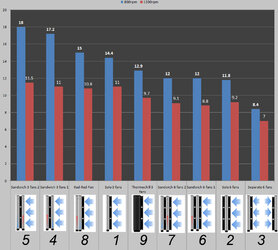
Image credit to martin liquid lab
http://martinsliquidlab.org/2012/06/08/hesmelaughs-radiator-sandwich-testing
2, For AirFlow: Chassis FANS
Here, the choice is much easier. While static pressure still a good thing to have as high as possible, the general rule is higher CFM the better. Just weight that against how noisey a FAN is, and you be alright.
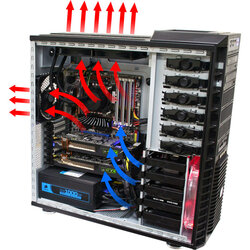
In general, you want to have a NET POSITIVE pressure in your chassis. If you know all the CFM of the fans, then the math is easy, just be sure the intakes is roughly 50CFM more than exhausts, and you be golden.
Also, general rule is that we like Fans to blow-in from front and side, exit back and top. Reason being hot air naturally raises, though easily overcome, there's little reason to fight nature's way. Of course, obstructions outside of your chassis matters too, and you need to be flexible. In general, most people that have internal Radiators, like to have RADS as exhaust, as blowing air through the rad as intake, can heat up your chassis by up to 10'C-15'C. Of course, that's why many of us, consider external radiators too, which usually gives good performance in cost of good looks.
Take note, many 38mm FANs at LOWER RPM actually gives pretty good ratio of such, don't forget looking into those. A good example will be Ultra Kaze 38mm Fan, or Cooler Master's turbine. Of course, I care about the looks too. I personally think Enermax fans gives a good balance between Performance and Noise here. Love them.
Noctua fans actually perform well too, but they are ... not my colors.
3, Very quiet fans
Some people cannot stand noise, and in this catagory, you don't have much to pick from, most fans will operate at <50CFM, but if you want it quiet, that's the performance you give up. (you can always construct a audio-insultating box for your computer if you want both.) To compensate, get more radiators to dissipate the heat better. If you are NOT on water cooling, then you need to watch your temps, and on air cooling.. chances are, using the most quiet fans will affect your clock speed, as you are bound to overheat. what you can do, is add copper fins to very hot surfaces, increase the surface area will help the heat dissipation, A LOT. Another solution, is applying some acoustic insulating foam on your chassis, I did so as I am a perfectionist, however, that only reduce the noise 'ever so slightly', (on the meter, just a 36dB -> 34dB reduction. makes me happy.)
With this. Hopefully it will help your understanding of fans.
and remember, fans are MOST abundant at the 120mm size, that is why most of us use that width for radiators. As we have most choices there, and can be much more flexible. Also note many chassis are made for you to use 120 radiators too.
QUICK GUIDE on fan specs:
AIRFLOW:
<50 CFM is weak. probably a fan marketted for be 'super quiet'.
>80 CFM is good.
>90 CFM is great.
(please note, some use CMH, 0.6xCMH = CFM )
PRESSURE:
> 2.8MMH20 = good enough.
(please note, some use mmHg instead. 1mmHg = 13.6mmH20)
NOISE:
<25 = super quiet.
<35 = acceptable.
>42 = really think twice if u next to computer.
ENJOY!
Update: 07-Jan-2014
- The last 4-6 months has been decent for fans. Many more fans are now avail and much more easily so as well.
Of course, I have been testing. and here are some of my new favorities:
- Scythe GentleTyphoon Ap-29 3000 rpm. This beast at max 36.5dB, but can pack a DENSE PUNCH, Excellent for radiators!
- CoolerMaster Jetflo 120mm 1600 rpm. This fan has 95CFM, however I find the static pressure less than the advertised, but as a chassis fan it is still excellent, for the cost.
Last edited:
